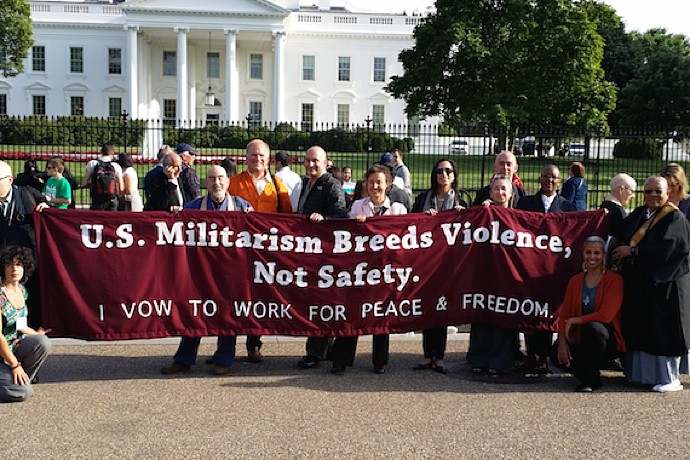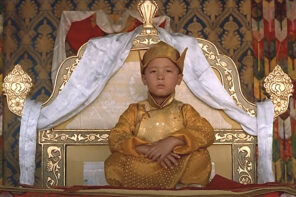Last week, dozens of senior Buddhist teachers and leaders converged on Washington, D.C. for an historic first meeting with U.S. government leaders. The gathering offered the assembled a chance to explore ways to encourage greater civic engagement and political action on the part of the few-million Buddhists in America.
Among the subjects addressed were climate change; social, economic, and racial justice—and peace, anti-violence, and disarmament.
In just the few days since the meetings took place, this last topic has risen to the fore, thanks in large part to a widely-circulated photo. Immediately following the meeting, Katie Loncke, Co-Director of the Buddhist Peace Fellowship, took full advantage of a unique opportunity and collected several well-known Buddhist teachers for a photo in front of the White House.
Together with such prominent Buddhists and scholars such as Lama Surya Das and Virtual Orientalism author Jane Iwamura, Loncke and other attendees held aloft a large banner reading: “U.S. Militarism Breeds Violence, Not Safety. I Vow to Work for Peace & Freedom.”
But not everyone was on board. In a blog post entitled “I Wish I Could Agree”, popular Zen teacher Brad Warner wrote:
The banner those Buddhists leaders unfurled in front of the White House is not true. US militarism sometimes does make us safer. It is not a good solution. And it always breeds some level of violence in response. But to say that it doesn’t make us safer in the short term, and thereby allow us to work on better solutions, is naive and unworthy of people who would define themselves as “Buddhist leaders.”
In an open letter to Warner, Co-Director of the BPF Dawn Haney responded:
As a Buddhist activist, I appreciate how the dharma helps me to hold paradox and contradiction, which is necessary for challenging systemic harms while not having the luxury for stepping outside of them. There is no pure place from which we can critique. In saying, “We Buddhists only get to be nice, soft, peace-loving wimps (let’s please be honest about that) because other people are willing to put themselves in harm’s way to protect us,” you imply that critique is not possible from this paradoxical position. I respectfully would argue that our position within U.S. empire requires us to critique it, and also be prepared that our lives and privileges will change as it transforms.
Though this particular conversation is not over, it is merely the latest in a series of such debates across the American Buddhist landscape about the Dharma, pacifism, and militarism.
At this point, some readers might be asking exactly the same thing that Foreign Policy did not long ago: “Isn’t Buddhism a religion that places respect for life and the embrace of peace at the very center of its worldview?” While you would be hard-pressed to find a Buddhist who would not answer this question in the affirmative, the “yes” might come with significant qualifications—or even eccentric interpretations that differ from secular understanding.
Buddhist religions—yes, the diversity of traditions is enormous enough that scholars are now speaking of them as plural religions—are religions like any other (no matter how much practitioners may insist otherwise), and so, to quote an oft-referenced teaching, when it comes to attitudes toward war and violence, “things are not what they seem, nor are they otherwise.” This is why, for example, the Dalai Lama says, on the one hand, that “the principle of nonviolence should be practiced everywhere,” while, on the other hand, in reference to the killing of Osama bin Laden, that “forgiveness doesn’t mean forget what happened… If something is serious and it is necessary to take counter-measures, you have to take counter-measures.”
As Buddhist scholar Stephen Jenkins counsels, “We must be careful to understand what ‘nonviolence’ means [when the Dalai Lama uses the term]. Under the right conditions, it could include killing a terrorist.”
Indeed, the Princeton Dictionary of Buddhism’s co-authors, Donald S. Lopez, Jr., and Robert E. Buswell, Jr., have it right when they label the notion that “all Buddhists are pacifists” a misconception. The religion’s first ethical precept may be “do not kill,” but a whole host of scholars (including Sallie B. King, Michael Jerryson, Mark Juergensmeyer, Tessa Bartholomeusz, Damien Keown, Brian Daizen Victoria, and Robert M. Bosco) have done much to detail the often quite complicated relationships that some Buddhist individuals and groups have had to physical force and militarism throughout history in different parts of the world. In the research, we find everything from theological justifications for national war efforts to instances of monastics taking up arms. (Of course, one need look no further than today’s headlines for evidence of brutality perpetrated by Buddhists: the humanitarian crisis involving Burma’s Rohingya minority has been purposely aggravated by the fanatical monk U Wirathu and his “969 Movement.”)
In his book An Introduction to Buddhist Ethics, Peter Harvey chalks these seeming inconsistencies between Buddhist peacefulness in theory and practice up to “unresolved human fears and attachments aggravated by politically unstable times.” But whatever the reasons, this much is clear: the role of Buddhists and Buddhism in violence and warfare has been more complicated than popular understanding would have us believe.
As Buddhist religions continue to make inroads in the United States, old debates about the Dharma, pacifism, and militarism continue to evolve. This is to be expected in a nation that, as Jonathan Turley notes, has been at “perpetual war” for more than fifty years. Despite the profound human cost unending war “represents perpetual profits for a new and larger complex of business and government interests.” (In fact, only a day after the Buddhists’ White House gathering, the House of Representatives passed a military spending bill that requests a whopping $612 billion for the year.)
Fittingly, the conversation about the BPF’s banner photo-op is not the only one about war and peace taking place in Buddhist America at the moment.
In a recent article for the Journal of Buddhist Ethics, for example, Robert M. Bosco notes that the U.S. military now boasts over five thousand avowed Buddhists across the different branches of the armed forces. With this rise of dharma practitioners in the services has come a need for Buddhist chaplains, and several have been commissioned in the last fifteen years. (Two of them, the Army’s Somya Malasri and the Navy’s Aroon Seeda, were among the attendees at the White House gathering.)
Bosco notes, however, that many Buddhists in the U.S. military have retreated to online communities due to the prevailing support for nonviolence among American converts to Buddhism. “When viewed in the larger social and cultural context of American Buddhism, the development of this new cyber-sangha of American Buddhist soldiers represents a new generation’s answer to the predominantly anti-war Buddhism of 1960s and 1970s that continues to define Buddhism in the public imagination,” he writes.
Elsewhere, two titans of Theravada Buddhism in the United States have found themselves at loggerheads over their differing views about defensive war. In one of the final issues of the progressive Buddhist journal Inquiring Mind, released in the middle of last year, monk and translator Ven. Bhikkhu Bodhi (who also attended the White House meeting) courted controversy with an article entitled “War and Peace: A Buddhist Perspective”. In it, he confirms that the Pali Buddhist tradition does bend strongly toward both pacifism and moral absolutism. At the same time, he wonders if military might could be right in some real-world scenarios. “It thus seems to me that the ethics of early Buddhism simply do not cover all the predicaments of the human situation,” he writes. “[In] circumstances where moral obligations run at crosscurrents… [I believe] we must simply do our best to navigate between them, rigorously examining our own motives and aspiring to reduce harm and suffering for the greatest number of those at risk.”
Ven. Thanissaro Bhikkhu, another notable teacher and translator in the Theravada tradition, disagreed vehemently with Bhikkhu Bodhi’s position, writing a lengthy letter to Inquiring Mind in which he outlined various objections. “The common view—that murderous force is an unfortunate but necessary last resort—is what has caused so much money, time and ingenuity to be lavished on that ‘last resort,’” he writes: “If we held to the principle of no intentional killing—with no ifs, ands or buts—it would force us to focus our ingenuity on ways of stopping enemies from harming us without our intentionally killing them.”
This letter set off a series of missives that, disappointingly, grow less and less helpful as they increase in number and length. When I spoke to Bhikkhu Bodhi about the fracas in an interview last fall, he cautioned against interpreting his statements as a blanket endorsement of military solutions:
I think what has to take priority now, since the formation of the United Nations, are the conditions for just warfare that are laid down within their charter. One is that a nation is justified in going to war only if it attacked by another nation and it needs to take immediate defensive action to prevent the prospect of immediate violence and destruction before the U.N. can intervene. The other condition is that collective warfare is justified if the U.N. Security Council deems it appropriate. In my understanding, none of the wars taking place in the world right now measures up to those criteria.
These are important qualifications, to be sure, but one might counter—just as Thanissaro Bhikkhu does in one of his letters—that while “it is possible to formulate a rationale for just war” such as this, it does not find any substantial basis in or meaningful support from Dharma teachings.
Of course, militarism encompasses much more than just the matter of defensive warfare, and Buddhist Americans would do well to delve deeper into those issues—something Katie Loncke hopes the BPF’s White House banner photo might inspire.
When I reached out to Loncke for comment, she talked about the multiple dimensions of U.S. militarism, including state control and terrorism, collateral death, the militarization of police forces, the prison-industrial complex, the violence of certain economic policies, and other ways that “our perception of ‘safety’ is enhanced through the dehumanization of ‘enemies’—cowboys being ‘safe’ from Indians; streets being ‘safe’ from (black and brown) criminals; democracies being ‘safe’ from terrorists, and so on.”
Buddhist Americans have only really scratched the surface of exploring, let alone responding to these issues—this is where Loncke, Haney, and the Buddhist Peace Fellowship have truly contributed to the development of Buddhism in America.
Speaking about the photo and the latest conversation it has launched, Loncke is optimistic about what may come: “My greatest hope is that the conversation on militarism can open up into thoughtful dialogue on who exactly is safer thanks to U.S. militarism, and who is not.”





